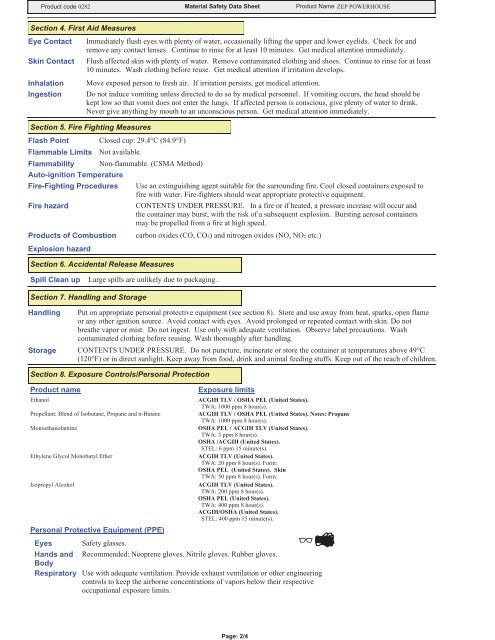Print MSDS - Miller Electric Company Publications
Print MSDS - Miller Electric Company Publications
Print MSDS - Miller Electric Company Publications
You also want an ePaper? Increase the reach of your titles
YUMPU automatically turns print PDFs into web optimized ePapers that Google loves.
Product code 0282<br />
Section 4. First Aid Measures<br />
Eye Contact<br />
Skin Contact<br />
Inhalation<br />
Ingestion<br />
Flash Point<br />
Material Safety Data Sheet Product Name ZEP POWERHOUSE<br />
Immediately flush eyes with plenty of water, occasionally lifting the upper and lower eyelids. Check for and<br />
remove any contact lenses. Continue to rinse for at least 10 minutes. Get medical attention immediately.<br />
Flush affected skin with plenty of water. Remove contaminated clothing and shoes. Continue to rinse for at least<br />
10 minutes. Wash clothing before reuse. Get medical attention if irritation develops.<br />
Move exposed person to fresh air. If irritation persists, get medical attention.<br />
Do not induce vomiting unless directed to do so by medical personnel. If vomiting occurs, the head should be<br />
kept low so that vomit does not enter the lungs. If affected person is conscious, give plenty of water to drink.<br />
Never give anything by mouth to an unconscious person. Get medical attention immediately.<br />
Section 5. Fire Fighting Measures<br />
Closed cup: 29.4°C (84.9°F)<br />
Flammable Limits Not available.<br />
Flammability Non-flammable. (CSMA Method)<br />
Auto-ignition Temperature<br />
Fire-Fighting Procedures Use an extinguishing agent suitable for the surrounding fire. Cool closed containers exposed to<br />
fire with water. Fire-fighters should wear appropriate protective equipment.<br />
Fire hazard CONTENTS UNDER PRESSURE. In a fire or if heated, a pressure increase will occur and<br />
the container may burst, with the risk of a subsequent explosion. Bursting aerosol containers<br />
may be propelled from a fire at high speed.<br />
Products of Combustion carbon oxides (CO, CO2) and nitrogen oxides (NO, NO2 etc.)<br />
Explosion hazard<br />
Section 6. Accidental Release Measures<br />
Spill Clean up Large spills are unlikely due to packaging.<br />
Section 7. Handling and Storage<br />
Handling<br />
Storage<br />
Put on appropriate personal protective equipment (see section 8). Store and use away from heat, sparks, open flame<br />
or any other ignition source. Avoid contact with eyes. Avoid prolonged or repeated contact with skin. Do not<br />
breathe vapor or mist. Do not ingest. Use only with adequate ventilation. Observe label precautions. Wash<br />
contaminated clothing before reusing. Wash thoroughly after handling.<br />
CONTENTS UNDER PRESSURE. Do not puncture, incinerate or store the container at temperatures above 49°C<br />
(120°F) or in direct sunlight. Keep away from food, drink and animal feeding stuffs. Keep out of the reach of children.<br />
Section 8. Exposure Controls/Personal Protection<br />
Product name Exposure limits<br />
Ethanol ACGIH TLV / OSHA PEL (United States).<br />
TWA: 1000 ppm 8 hour(s).<br />
Propellant; Blend of Isobutane, Propane and n-Butane ACGIH TLV / OSHA PEL (United States). Notes: Propane<br />
TWA: 1000 ppm 8 hour(s).<br />
Monoethanolamine OSHA PEL / ACGIH TLV (United States).<br />
TWA: 3 ppm 8 hour(s).<br />
OSHA /ACGIH (United States).<br />
STEL: 6 ppm 15 minute(s).<br />
Ethylene Glycol Monobutyl Ether ACGIH TLV (United States).<br />
TWA: 20 ppm 8 hour(s). Form:<br />
OSHA PEL (United States). Skin<br />
TWA: 50 ppm 8 hour(s). Form:<br />
Isopropyl Alcohol ACGIH TLV (United States).<br />
TWA: 200 ppm 8 hour(s).<br />
OSHA PEL (United States).<br />
TWA: 400 ppm 8 hour(s).<br />
ACGIH/OSHA (United States).<br />
STEL: 400 ppm 15 minute(s).<br />
Personal Protective Equipment (PPE)<br />
Eyes<br />
Hands and<br />
Body<br />
Respiratory<br />
Safety glasses.<br />
Recommended: Neoprene gloves. Nitrile gloves. Rubber gloves.<br />
Use with adequate ventilation. Provide exhaust ventilation or other engineering<br />
controls to keep the airborne concentrations of vapors below their respective<br />
occupational exposure limits.<br />
Page: 2/4



